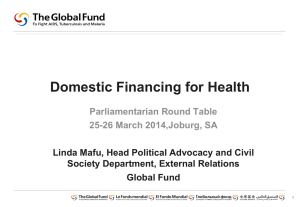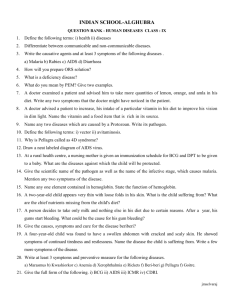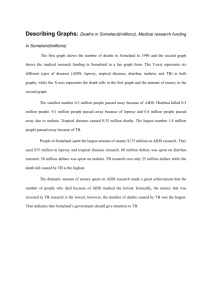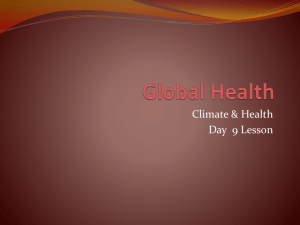Health, equity and globalization
advertisement
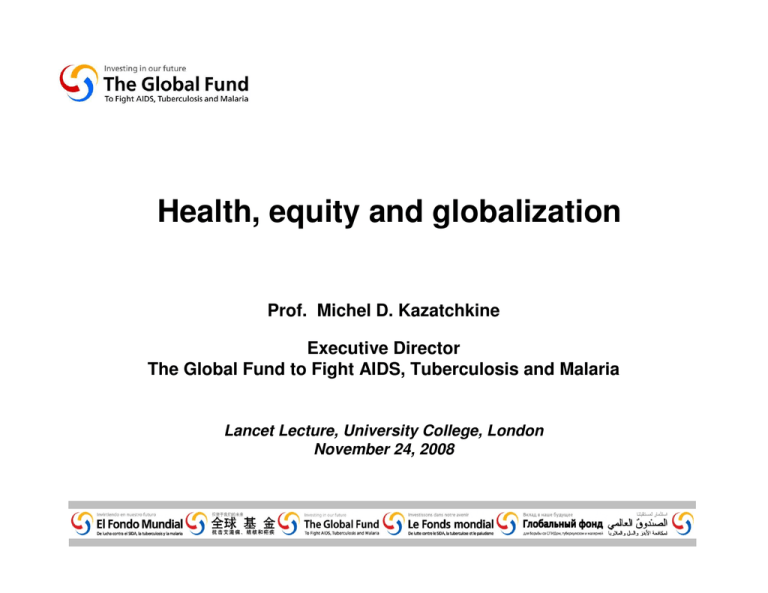
Health, equity and globalization Prof. Michel D. Kazatchkine Executive Director The Global Fund to Fight AIDS, Tuberculosis and Malaria Lancet Lecture, University College, London November 24, 2008 Outline (1) • Globalization has contributed to poverty reduction in developing countries; however there are also growing inequities • Health has become a key focus of international action to address such inequities between the global north and south • The Global Fund is an innovative instrument for helping to reduce global health inequities • Significant challenges remain to sustain global health efforts Globalization: more wealth, but also more inequity • Unprecedented global economic growth in the past decade (BRIC bloc) • Increased inequities within countries and between the richest and poorest countries • Financial crisis could further exacerbate such inequities Poverty reduction has been accompanied by rising inequality MDG Report 2007 (UN) •The proportion of people living in extreme poverty (<$1 a day) in developing countries has declined from 32% to 19% between 1990 and 2004 •But this has been accompanied by rising inequality within developing countries overall Increasing income inequality between richest and poorest countries Gross National Income per capita in nominal US dollars Year Richest countries Poorest countries Ratio 1980 $ 11 840 $ 196 60 2000 $ 31 522 $ 274 115 2005 $ 40 730 $ 334 122 WHO Commission on Social Determinants of Health 2008 Unstable relationship between economic growth and progress in life expectancy Global economic downturn could increase inequities • Developing country economy growth projection marked down from 6.4% to 4.5% in 2009 •An additional 40 million people in poverty in 2009 The inequitable burden of infectious disease • 90% of the burden of infectious disease is concentrated in developing countries, whereas those countries account for only 20% of the world’s wealth and only 12% of global expenditure on health • AIDS, TB and malaria are the major infectious diseases and still kill over 4 million people a year Why health funding can no longer be so “soft” • Health is a key investment for development • Investments in health are showing results and impact • AIDS treatment and health systems challenges highlight need for long-term effort and lifetime commitments • Sustainability is a responsibility shared by countries and the international community • Convergence of donor political and economic interests with global health outcomes Breaking the silence “I exist as a living embodiment of the inequity of drug availability and access in Africa … ... I stand before you because I am able to purchase health and vigour. I am here because I can pay for life itself.” - Justice Edwin Cameron International AIDS Conference, Durban, 2000 Outline (2) • Globalization has contributed to poverty reduction in developing countries; however there are also growing inequities • Health has become a key focus of international action to address such inequities between the global north and south • The Global Fund is an innovative instrument for helping to reduce global health inequities • Significant challenges remain to sustain global health efforts Key developments • Millennium Development Goals • Social mobilization • Political commitment • New resources • New instruments Millennium Development Goals (2000) MDG 1: Eradicate extreme poverty and hunger MDG 2: Achieve universal primary education MDG 3: Promote gender equality and empower women MDG 4: Reduce child mortality MDG 5: Improve maternal health MDG 6: Combat HIV/AIDS, malaria and other diseases MDG 7: Ensure environmental sustainability MDG 8: Build a partnership for development Social mobilization and political commitment Total health ODA commitments, 2001-2006 UNAIDS New instruments in global health • World Bank Multi-country AIDS Program (2000) • Global Alliance for Vaccines and Immunization (2000) - International Finance Facility for Immunization • Global Fund to Fight AIDS, TB and Malaria (2002) • US President’s initiatives - • • • • • • AIDS (2003), Malaria (2005), Neglected Tropical Diseases (2008) Unitaid (2005) (PRODUCT) Red (2005) World Bank Malaria Booster Program (2005) Debt2Health (2007) Advanced Market Commitments (2008) Affordable Medicines Facility for Malaria (2009) Outline (3) • Globalization has contributed to poverty reduction in developing countries; however there are also growing inequities • Health has become a key focus of international action to address such inequities between the global north and south • The Global Fund is an innovative instrument for helping to reduce global health inequities • Significant challenges remain to sustain global health efforts The Global Fund: an innovative instrument in health and development • A financial instrument, not an implementing entity • Supports programs that reflect country ownership • Evidence-based • Performance-based A unique partnership The Global Fund: an innovative instrument in health and development • A financial instrument, not an implementing entity • Supports programs that reflect country ownership • Evidence-based • Performance-based Global Fund portfolio • $14 billion in approved financing • $7 billion disbursed • 600+ grants in 140 countries Global Fund portfolio: AIDS Global Fund portfolio: malaria ! " # % Global Fund portfolio: TB $ ! " # ! $ &' & ( & 140 countries with Global Fund grants 1 2 (new) 3 (new) 4 (new) 5 (new) 6 (new) 7 (new) 0 2,500 5,000 Kilometers BG/261107/6 Targeting the poorest countries: Global Fund approved amounts by country per capita income, September 2008 3500 3000 2500 2000 1500 1000 500 $m 0 US$ 0-1000 US$1000-2000 US$2000-5000 US$5000-10000 Other Resources go where they are needed • Regions – 60% of approved funds in Rounds 1-8 are for sub-Saharan Africa – 65% of funding for orphan support is for southern Africa • Diseases AIDS: 35% of Global Fund financing for ART is for southern Africa Malaria: $1.5 billion approved for 19 African countries that account for 90% of malaria burden in Africa TB: More than $1 billion approved for 22 high burden countries that account for 80% of global TB incidence Reaching the vulnerable e.g. Global Fund support to harm reduction programmes No Global Fund grants 0 1,100 Kilometers 2,200 Global Fund grant, with financing of harm reduction ´ Number of people receiving ARV therapy in low- and middle-income countries, 2002—2007 People receiving ARV therapy (in Millions) 3.0 North Africa and the Middle East Europe and Central Asia East, South and South-East Asia Latin America and the Caribbean 2.8 2.6 2.4 Sub-Saharan Africa Global Fund supported programs 2.2 2.0 1.8 1.6 1.4 1.2 1.0 0.8 0.6 0.4 0.2 0.0 end 2002 end 2003 end 2004 end 2005 end 2006 end 2007 Global Fund results: June 2008 )(( *+ & & 4.5 4 60 DOTS ARVs 3.5 ITNs 50 45 40 35 2.5 30 2 25 1.5 /.0 & ) +,& $- . 3 55 20 15 1 10 0.5 5 0 - Dec-04 Jun-05 Dec-05 Jun-06 Dec-06 Jun-07 Dec-07 Jun-08 GP/110608/9 AIDS impact: Malawi Initial decline in workplace mortality at Escom (national electricity company) after roll-out of antiretroviral treatment Source: Global Fund Decline in adult mortality with introduction of ART: Botswana 5 50 on ARV Deaths aged 25-54 40 4 30 3 20 2 10 1 0 0 1991 1992 1993 1994 1995 1996 1997 1998 1999 2000 2001 2002 2003 2004 2005 Persons on ARV (Thousands) Registered Deaths (Thousands) 6 Increase in TB financing and new sputum positive cases detected and treated New SS+ cases treated under DOTS 300,000,000 1.9M 250,000,000 276M 1,500,000 1.4M 200,000,000 2,000,000 196M 150,000,000 107M 1,000,000 127M 100,000,000 41M 50,000,000 - 0.38M 0.6M 500,000 0.5M 2002 2003 2004 2005 2006 2007 New SS+ cases treated under DOTS (annual) Annual amount disbursed (in US$) Amount disbursed (US$) Malaria in-patient and out-patient laboratory-confirmed 4,500 4,000 3,500 3,000 2,500 2,000 1,500 1,000 500 0 Mar-01 Apr-01 2001 May-01 Jun-01 Apr-02 May-02 Jun-02 Jul-02 Aug-02 Sep-02 Oct-02 Nov-02 Dec-02 Jan-03 Feb-03 Malaria in-patient cases Feb-02 Mar-02 Out-patient confirmed cases Oct-01 Nov-01 Dec-01 Jan-02 Non-malaria in-patient cases Jul-01 Aug-01 Sep-01 2002 WHO national database Jan-01 Feb-01 2003 Mar-03 Apr-03 May-03 Jun-03 Jul-03 Aug-03 Sep-03 Oct-03 Nov-03 Dec-03 Jan-04 2004 Month Feb-04 Mar-04 Apr-04 May-04 Jun-04 Jul-04 Aug-04 Sep-04 Oct-04 Nov-04 Dec-04 Jan-05 Feb-05 2005 Mar-05 Apr-05 May-05 Jun-05 Jul-05 Aug-05 Sep-05 Oct-05 Nov-05 Dec-05 Jan-06 Jun-06 Jul-06 Aug-06 Sep-06 Oct-06 Nov-06 Dec-06 Jan-07 Feb-07 2007 Mar-07 Apr-07 May-07 Jun-07 Jul-07 Aug-07 Sep-07 Interventions 2006 Apr-06 May-06 Incidence ~64% Feb-06 Mar-06 Oct-07 Nov-07 7,000 6,000 5,000 4,000 3,000 2,000 1,000 0 Non-malaria in-patient cases Declining malaria in health facilities after scale-up of bed nets and anti-malaria treatment: Rwanda, 2001-2007 cases Impact: malaria Tanzania accelerating reduction of child mortality (MDG 4 & 6) Interventions: ITNs and malaria treatment with integrated management of childhood illness MDG targets Masanja et al, Lancet, 2008 Addressing health systems challenges • Human resources • Procurement systems for drugs and health commodities • Infrastructure • Laboratory equipment • Monitoring and evaluation systems Direct funding of health systems through Global Fund grants Other 10% Administration 10% Monitoring and Evaluation 3% Health Systems 35% Commodities, Products, Drugs 45% ! " Infrastructure and Equipment 9% Human Resources 23% The Global Fund and health systems strengthening • Direct funding of health systems through disease interventions (approximately $945 million for Round 8; more than $4 billion overall) • Health systems support across more than one disease – $186 million approved in Round 7 – $ 290 million approved in Round 8 (health workforce, information systems, supply chain management, community service delivery) • Expanding health system capacity - Non-government actors (NGOs, FBOs, communities, private sector, people living with the diseases) are recipients of 50% of Global Fund funding - Dual track financing • Majority of Round 8 proposals included community systems strengthening Human resources • Increasing the number of health workers – Salaries for health workers & community health workers – Salary top-up • Training (96% of grants have a training component) • Saving lives of health workers to return to work • Reducing AIDS, TB and malaria burden so that health workers can focus on other health needs Infrastructure: Support for renovation of existing health centres Mukoma Health Centre, Rwanda (Source: PEPFAR) *Photo courtesy of FHI Laboratory strengthening • 67% of TB grants included laboratory strengthening Examples: • Chad: Newly equipped laboratories • Philippines: Training in sputum microscopy (public and private) • Yemen, Sri Lanka: New laboratories established Outline (4) • Globalization has contributed to poverty reduction in developing countries; however there are also growing inequities • Health has become a key focus of international action to address such inequities between the global north and south • The Global Fund is an innovative instrument for helping to reduce global health inequities • Significant challenges remain to sustain global health efforts Resource needs for AIDS, TB and malaria (2009 to 2015) Sources: UNAIDS, STB, RBM Estimated resource needs 60 50 US$bn 40 HIV/AIDS TB 30 Malaria 20 10 0 2009 2010 2011 2012 2013 2014 2015 Total ODA commitments, all sectors, 2001-2006 ! " # $! "$ # ! % &'(&)*+,,- Resources: increasing both availability and demand Estimated Need Estimated Need Demand Available resources $ US billion Available resources and demand Global Fund requested and approved 2-year funding (Rounds 2 – 8) 7000 53% 5791 6000 Approval rate Millions, US$ 5000 40% 34% 39% 22% 34% 47% 4000 3298 3000 2512 2137 2000 1000 3059 2519 2398 1853 620 860 968 726 1119 847 0 Round 2 Round 3 Phase 1 request, million US$ Round 4 Round 5 Round 6 Round 7 Round 8 Phase 1 upper ceiling request for TRP recommended proposals, million US$ Sustainability: more than resources alone • Increased and more predictable resources (domestic, external, further innovation) • Build demand for resources • Address health systems challenges • Promote evidence-based interventions effectively targeted to those in need • Promote human rights • Strengthen social protection • Strengthen global and local partnerships • Learn and apply lessons: research and evaluation Increasing Coverage of Health Care in Rwanda Scaling up Health Insurance 80% 7,000,000 Number of beneficiaries 6,000,000 5,000,000 4,000,000 3,000,000 Improving Access to Health Care Global Fund subsidy 2 m illion 72% 2005 60% Global Fund cofinance subsidy 44% Out-of-pocket and/or Government subsidy 1,3 m illion 2,000,000 3 million 40% 2006 49% 40% 43% 35% 20% 1,000,000 0 7,800 300,000 900,000 P rivate health Civil Geno cide Co mmunity insurance servants/M ilitary survivo rs, health insurance priso ners (398 mutuelles) 0% P o pulatio n co verage with health insurance P o pulatio n with at least o ne co nsultatio n in health center Utilizatio n rate o f district ho spitals Strengthening partnership • Global and local • Harmonization and alignment Paris, Accra, IHP • UNAIDS • WHO • World Bank • UNICEF • Stop TB • Roll Back Malaria • Bilaterals • GAVI • Civil society • Private sector Study areas of the 5-year evaluation of the Global Fund (2008) • Organizational efficiency • Effectiveness of the Global Fund as a partnership • Impact studies in 16 countries
